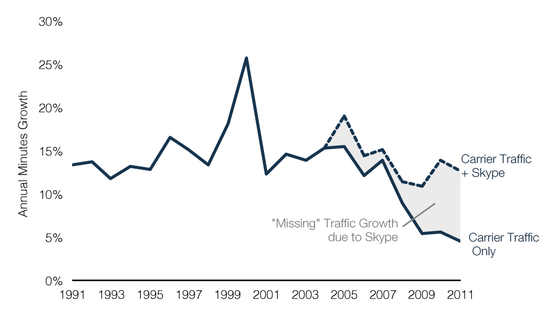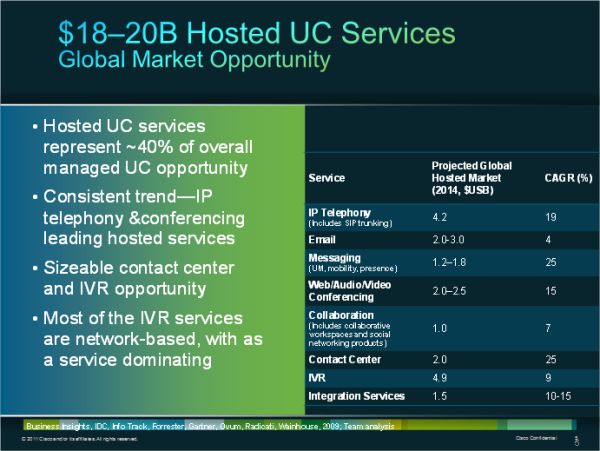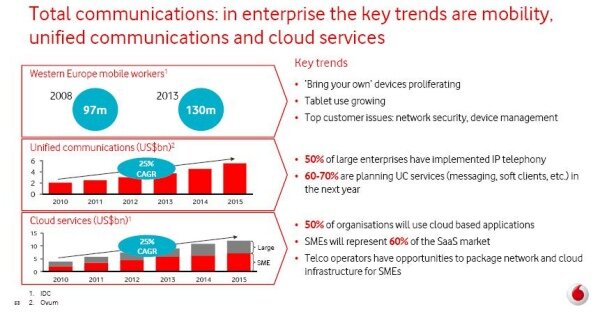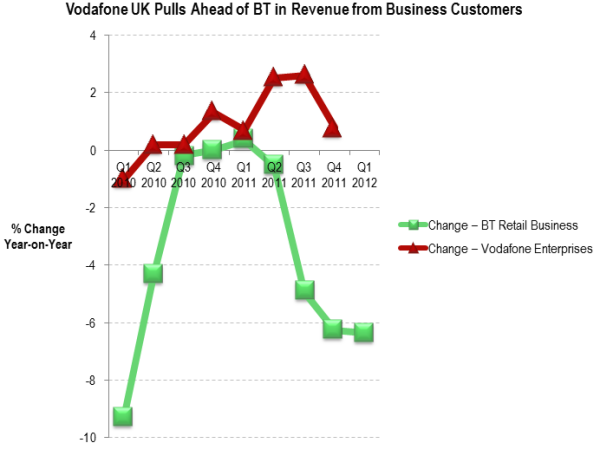| Summary: Vodafone have been quietly stealing a march in the European SMB communications market with a well executed strategy centred on its OneNet cloud-based product. We look at how, including comparisons with BT, Telenor, and others. (May 2012, Executive Briefing Service) |
|
Below is an extract from this 24 page Telco 2.0 Report that can be downloaded in full in PDF format by members of the Telco 2.0 Executive Briefing service here. Non-members can subscribe here, buy a Single User license for this report online here for £795 (+VAT for UK buyers), or for multi-user licenses or other enquiries, please email / call +44 (0) 207 247 5003.
We'll also be discussing our findings at the London (12-13 June) New Digital Economics Brainstorm where we'll be joined by Bob Brace, Vodafone's Head of Cloud and Unified Comms, in the Cloud 2.0 stream.
To share this article easily, please click:
Although voice minutes of use are still rising slowly worldwide, it is increasingly the case that the predictions of falling revenues from traditional services are becoming a reality, and sooner than expected. A combination of regulatory pressures, price competition between operators, and disruptive competition from new entrants is crushing margins.

Source: TeleGeography
Most worryingly, the continued huge growth in volumes at Skype and the popularity of alternative messaging options like WhatsApp, BlackBerry Messenger, and Apple's iMessenger show that the disruption is disproportionately affecting the most profitable segments of the traditional telecoms bundle – international and SMS respectively.
Increasingly, small and medium-sized businesses (SMBs), another key line of business, are turning to the growing numbers of independent VoIP providers. And, more broadly, voice, messaging, and video conferencing features are being disaggregated and diversified, showing up in all kinds of software, hardware, and Web service contexts – exactly as we predicted in 2007.
Again as we predicted, voice is more and more being delivered as part of a broader communications product. In the enterprise, this typically manifests itself as a “unified communications” (unicomms or UC) application, integrating telephony, voicemail, e-mail, and often also instant messaging, presence-and-availability, teleconferencing, and collaboration tools. This can be delivered on-premises, for example by an Asterisk system or an integrated hardware appliance like the ones Cisco sells, as a Web service (like Huddle or Salesforce Chatter), as a hosted/cloud-based network service, or as a telecomms operator service (like IP-Centrex).
In this context, some operators are not just surviving but succeeding. There is not only crisis here, but also opportunity. Cisco forecasts that there is a world market for $20bn of hosted unified-comms services, making up about 40% of the total “managed” UC market. Vodafone expects a 25% CAGR over the next four years in both UC and cloud services for SMBs and enterprises, with a total European market of $15bn in 2015. As for the broader communications market, BT estimates that the total UK SMB communications market is worth some £29bn from 4.8 million customers.

The drivers are clear - SMB customers are keen to get rid of the costs of owning and managing local PBXes on the one hand, to enjoy the (perceived) low, low prices of VoIP, and also to upgrade their communications services from the early 1990s GSM feature set plus the late 1990s BlackBerry e-mail service to something more in keeping with the age of Google +, the Apple iPhone, and Skype.
At the same time, operators are in search of new sources of revenue to replace the business and international voice and SMS cash cows. As always, they also need to find applications that sell-through their basic connectivity products. Hardware vendors are keen to extend their own businesses, which are challenged by the availability of open-source software and cloud-based services. And the software and Internet service players are trying, in their turn, to defend against the remorseless drift towards “free”.
In this note, we will discuss three European operators' response to the challenge and the results, and we will also discuss how the vigorous Voice 2.0 disruptor ecosystem relates to the SMB core market. We will start with an example of success – Vodafone.

In the UK, this space is dominated by two players, Vodafone and the ex-incumbent BT. Their results contrast dramatically.
Vodafone is aggressively promoting a cloud-based UC package, OneNet, to its SMB customers in the six biggest European markets, and looking to roll it out across the wider Vodafone Group.
OneNet is a cloud-based unicomms product, which offers single numbers for both fixed and mobile telephony, advanced call management, multi-ring and hunt groups, and voicemail integrated with push e-mail across mobile devices, fixed phones, and VoIP softphones, with a single bill and central account management via a Web interface and a smartphone app. Vodafone also offer Office 365 from Microsoft as an extra cost option and later this year (2012) will offer integration between One Net and Microsoft Lync enabling “click to call from Microsoft applications and the ability to answer an incoming call to a mobile number in Lync.
OneNet Express is a lightweight version of the product for small businesses, offering virtual landline numbers and some call management features, as well as the account management service, for mobile lines only. Both versions of the product are delivered as pure network services, running in Vodafone's core network.
Although Vodafone is increasingly keen to boast about its performance in the SMB and enterprise markets, it doesn't yet provide a line-of-business analysis in its accounts. However, we’ve constructed a roughly comparable data series, based on the growth figures Vodafone does provide, its own statement that 31% of its European revenue is from business customers, and its geographical segment breakdowns.
A caveat must be introduced in that Vodafone Global Enterprises (VGE), the large enterprise & government business roughly analogous to BT Global Services, is included in the Vodafone series while BTGS is broken out in the BT accounts. BT does not provide a breakdown of BTGS revenue detailed enough to create an identical BT series. However, as we will soon see, it is unlikely that Global Services have contributed enough growth to falsify the conclusion we are about to draw.
In the six OneNet markets (Germany, Italy, Spain, the UK, the Czech Republic, and Portugal) through 2011, revenue growth averaged 4.8%, and it is worth noting that there is substantial momentum. Q1 saw sequential growth of 2.4%, Q2 4.85%, and Q3 7.38%. In the market and economic context, this is a spectacular performance.

In the last 7 quarters, Vodafone's revenue from UK business customers grew in 6 of them. It beat BT in every one of the quarters we looked at. Not only is it growing quite quickly, while BT's is shrinking dramatically, it is almost three times as big in absolute terms (although some of this will be down to the differences in segment allocation).
In Europe more broadly, the same picture is visible even more strongly, with the SMB segment growing at 5-8%% in major markets like Germany and Italy, and accounting for most of the growth in final ARPU. Although Vodafone’s south European interests are in the firing line of the economic crisis, this line of business has been remarkably robust. In the last three months of 2011, service revenue in Italy shrank almost 5 per cent – but revenue from SMBs and enterprises rose 1.9%. At the same time, service revenue in Germany grew 0.3%, but the OneNet target markets grew 5%. In Q2, service revenue in Italy was down 4.1%, but enterprise was up 5.8%, and OneNet itself was growing at 70% annually. In Germany, at the other end of the European economic spectrum, enterprise was up 6.6% year on year compared with total service revenue at 1.2%.

To read the note in full, including the following additional analysis...
...and the following figures...
...Members of the Telco 2.0 Executive Briefing Subscription Service can download the full 24 page report in PDF format here. Non-Members, please subscribe here, buy a Single User license for this report online here for £795 (+VAT for UK buyers), or for multi-user licenses or other enquiries, please email / call +44 (0) 207 247 5003.
Technologies and industry terms referenced: SMBs, strategy, voice, unified communications, channel marketing, partners, business model, Vodafone, BT, Telenor, Twilio, Tropo, VOIP.